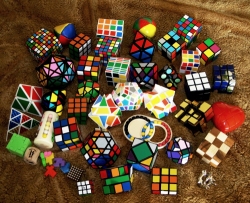Twisty Puzzles
A three dimensional twisty puzzle is usually made of a set of pieces that can change their position through a group of operations, obtaining different combinations. Physically, the rearrangement of positions is done through the rotation (twist) of some pieces around a point of the polyhedron (which may represent one of the pieces of the puzzle), which is usually located at the center of a face or a corner.
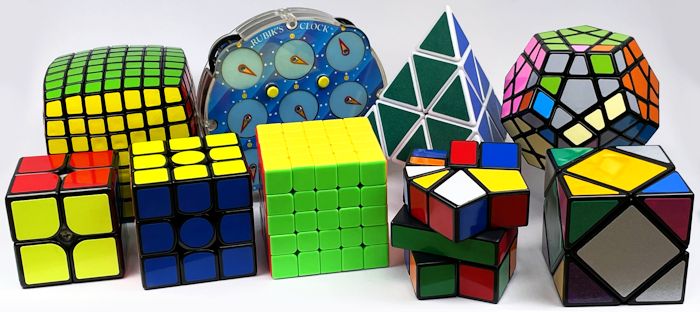
Official competition puzzles
These puzzles are all the descendants of the Rubik's Cube, invented in 1974 and there are countless variations of them. Usually the pieces are marked with colors and the solved state is usually represented by the position in which each face of the polyhedron contains pieces of a single color.
Twisty puzzles can be categorized in various ways based on their mechanisms, shapes, and other characteristics. Here’s a breakdown of the main categories for twisty puzzles:
1. Turning Mechanism
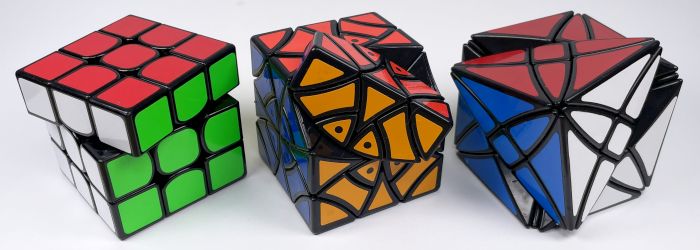
Face, edge and corner-turning twisty puzzles
- 1. Face-Turning Puzzles: These puzzles have faces that rotate around the central piece of the face. The color of the central pieces never changes location and it shows the color of the face in the solved state. The Rubik’s Cube is the most famous example, as well as the Megaminx.
- 2. Edge-Turning Puzzles: In these, rotation occurs along the edges rather than the faces. Examples include the Curvy Copter.
- 3. Corner-Turning Puzzles: These puzzles rotate around their corners. A classic example is the Skewb the Pyraminx.
- + Jumbling Puzzles: Jumbling is a phenomenon in twisty puzzles where pieces move in ways that deviate from their standard positions or layer structures. This typically happens when a turn is incomplete, but the puzzle still allows a perpendicular rotation, causing certain pieces (like corners) to occupy positions meant for different types of pieces (like edges).
For example, in a Curvy Copter, jumbling moves can "lock" the puzzle by creating configurations that prevent further movement. Meanwhile, in a Square-1, jumbling allows you to manipulate the layers freely, even moving all the smaller edge pieces to the upper layer, which isn’t possible in puzzles without jumbling.
2. Stickers
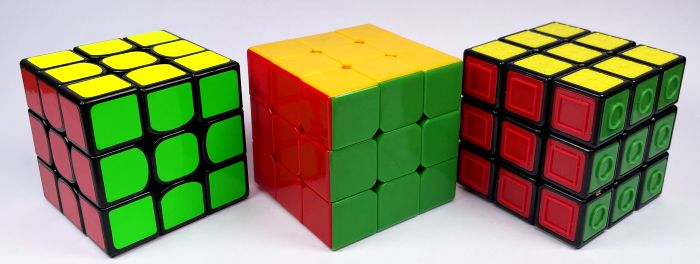
Stickered, stickerless and tactile cubes
- Stickered: These puzzles rely on stickers to indicate colors, making it possible to replace stickers for a custom look.
- Stickerless: These have colored plastic parts instead of stickers. They're often more durable and can prevent sticker wear. Puzzles with colored plastic are permitted on official WCA competitions, even if the color is visible inside the puzzle.
- Tiled: Like the Braille Cube and the Lego Cube, are variations with tactile elements. These cubes have distinct textures on each tile rather than just colors, making them accessible and fun for people who prefer or need to rely on touch rather than sight to solve the cube.
- Sticker Mods: or picture cubes provide a new challenge, combining jigsaw puzzles with Rubik's Cubes. The solution is similar if you manage to figure out where the pieces belong. The most important difference is that the orientation of the center pieces also counts.
3. Twisty Puzzle Shapes
- Cubes: These are the NxNxN puzzles, such as 2x2x2 Pocket Cube, 3x3x3 Rubik's Cube, 4x4x4 Professor's Cube, up to 17x17x17 and beyond, the current record being the 49x49x49 cube. If you can solve the even 6x6x6 and the odd 7x7x7 then you can solve any big cube.
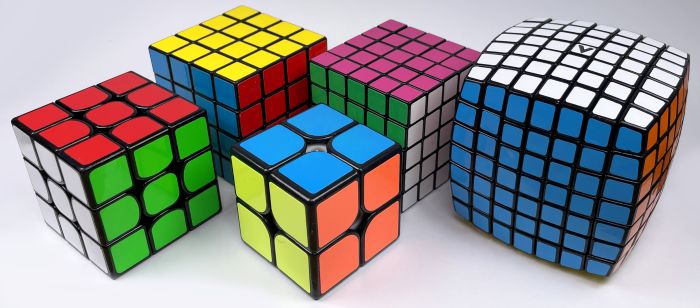
N×N×N cubes: from 2x2x2 to 7x7x7 - Cuboid: Face-urning puzzles with rectangular shape where shape-shifting comes into the calculation, like the 2x2x4 and we can't turn 90° on some faces if there are even layers, like the 3x3x4 Cube.
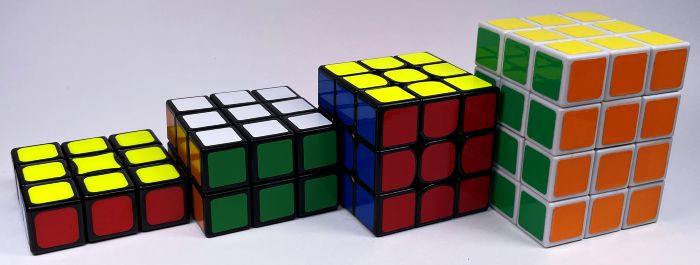
Various layers built on a 3x3 base: Floppy Cube, Domino Cube, Rubik's Cube and 3x3x4 - Polyhedra (or singular: polyhedron) are three-dimensional geometric solids with flat polygonal faces, straight edges, and vertices (corners). Each face of a polyhedron is a polygon, and they are joined at the edges.
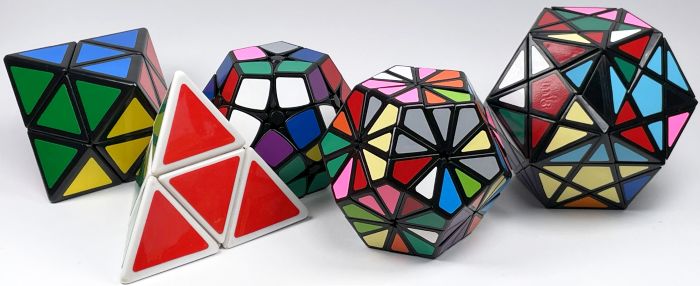
3.1. Shape-Shifting Puzzles
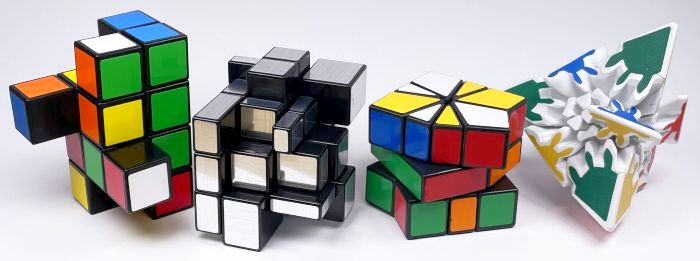
Shape-shifting twisty puzzles
- Non-Shape-Shifting puzzles retain their shape even when scrambled. Most traditional Rubik’s Cubes fall under this category.
- Shape-Shifting puzzles change their shape when scrambled, adding an extra challenge. The Mirror Cube is a famous example, as is the Ghost Cube.
3.2. Other Puzzle Variations
- Shape Mods: These modify the standard shapes of puzzles into others. We can build any unusual shape around the core mechanism of any puzzle, like turning a cube into a pyramid or even a SpongeBob Squarepants. You can find more examples on their dedicated page.
- Extended Puzzles: Some puzzles add extra pieces or layers to standard puzzles, like the Gigaminx or Petaminx (large dodecahedrons).
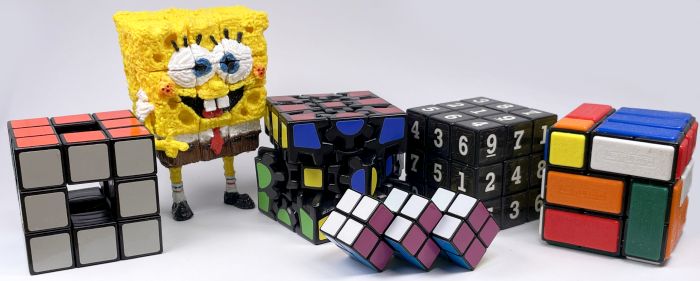
Special 3x3 modifications
- Geared Puzzles: where the pieces are interconnected with gears, causing them to rotate in sync with each other. When you turn one layer, the gears force adjacent layers to move as well, creating a visually intricate and mechanically complex experience.
- Holey Puzzles: don't have a central core. These holes give the puzzle a hollow, see-through appearance, allowing you to look through the puzzle as you twist and turn it. (e.g., Void Cube, image on the right)
- Bandaged Puzzles: Puzzles with certain pieces “bandaged” or locked together, making movement more challenging (e.g., Bandaged 3x3 cube - image on the right).
4. Non-Twisty Puzzles
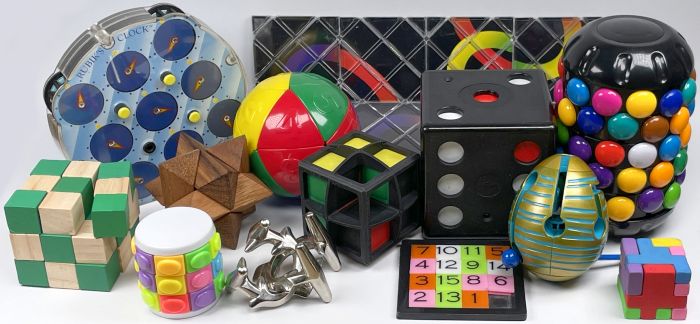
Non-twisty puzzles
-
Jigsaw Puzzles🧩: Traditional puzzles with pieces that fit together to form an image.
-
Sliding Puzzles: Puzzles where pieces slide in a grid, like the 15-puzzle, with the goal of arranging them into a specific order or pattern. Sliding puzzles can also be 3D.
-
Folding Puzzles: Like the Rubik's Snake or the Rubik's Magic involves folding the puzzle to achieve a certain shape or patterns.
-
Mechanical Puzzles: Physical puzzles with moving parts, such as disentanglement puzzles or lock puzzles that require strategic manipulation. Example: Rubik's Clock, that's a competition event.
-
Logic Puzzles: Puzzles that require logical reasoning to solve, like Sudoku, nonograms, and KenKen.
-
Crossword Puzzles: Word puzzles where clues are solved to fill in a grid with letters.
-
Word Search Puzzles: Grids of letters where words are hidden for players to find.
-
Math Puzzles 🧮: Puzzles that involve numbers and mathematical concepts, such as magic squares and Kakuro.
-
Puzzle Boxes: Boxes with hidden mechanisms that need to be manipulated in a specific way to open.
-
Assembly Puzzles: Puzzles where pieces must be arranged or combined in a specific way to form a shape or structure (e.g., tangrams, 3D wooden puzzles).
-
Maze Puzzles: Pathfinding puzzles where a player must navigate from the start to the finish. Play maze online.
-
Rebus Puzzles: Puzzles that use images, letters, or symbols to represent a phrase or word.
-
Cryptic Puzzles: Puzzles that involve deciphering codes or complex clues, such as ciphers and escape room puzzles.
-
Visual Puzzles: Puzzles that rely on visual perception, like "spot the difference👯" or optical illusions.
-
Trivia and Quiz Puzzles: Puzzles that require knowledge in various subjects to answer questions or solve clues. Take the Rubik's Cube quiz here.
-
Puzzle Hunts: Complex, multi-layered puzzles that combine different types, often used in competitions or games like scavenger hunts.
5. Most Popular Twisty Puzzles
The Rubik’s Cube remains the most iconic of these puzzles, boasting countless combinations and serving as the ultimate symbol of twisty puzzle culture. Other popular puzzles include the official WCA competition puzzles, like the Pyraminx, a pyramid-shaped twisty puzzle, the 12-sided Megaminx, and other puzzles listed below add even more to the challenge. They all seem to be impossible to solve, but Ruwix will guide you to learn their solutions.
NxNxN cubes
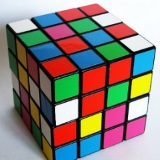
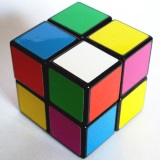 There are many NxNxN puzzle cuboids beside the 3x3x3 Rubik's Cube, the biggest being the 49x49x49, revealed in 2024. The largest-order mass-produced cube is the 17x17x17 by Yuxin (roughly $750). The 2x2 - 7x7 range are all official WCA competiton events.
There are many NxNxN puzzle cuboids beside the 3x3x3 Rubik's Cube, the biggest being the 49x49x49, revealed in 2024. The largest-order mass-produced cube is the 17x17x17 by Yuxin (roughly $750). The 2x2 - 7x7 range are all official WCA competiton events.
Skewb
 The Skewb was invented by Tony Durham in the early 1980s. It was released originally by Uwe Meffert as the “Pyraminx Cube”, but the name “Skewb”, coined by Douglas Hofstadter in his column about the famous puzzle back in 1982. The original name was suggested after the cube’s properties – It acts like a Pyraminx with 4 axes of rotation, but in the shape of a cube. The Skewb’s initial popularity was impressive, and several modifications were designed and released after the original cube’s entry into the market.
The Skewb was invented by Tony Durham in the early 1980s. It was released originally by Uwe Meffert as the “Pyraminx Cube”, but the name “Skewb”, coined by Douglas Hofstadter in his column about the famous puzzle back in 1982. The original name was suggested after the cube’s properties – It acts like a Pyraminx with 4 axes of rotation, but in the shape of a cube. The Skewb’s initial popularity was impressive, and several modifications were designed and released after the original cube’s entry into the market.
The puzzle garnered the attention of speedsolvers and the WCA, who saw the puzzle as something that would be amazing to speedsolve in official competitions. After the Magic and Master Magic puzzles were removed at the beginning of 2013, it was arguable that there was a gap in official WCA events, something that Skewb could fill perfectly. So, as of January 1st 2014, the Skewb has been an official event in the WCA, and many popular speedcubing companies have worked to produce some amazing speedcube-able variants of the popular puzzle.
Megaminx
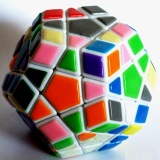 The Megaminx was invented by Christoph Bandelow in the early 1980s. It was release originally by Uwe Meffert in 1982 and named it the “Pyraminx Magic Dodecahedron”. This puzzle is notable due to its relative simplicity despite its apparent difficulty and impressive size. The Megaminx is not much more difficult than a 3x3 in solution terms; in fact, with knowledge of a simply 3x3 layer-by-layer beginner’s method and a bit of intuition, anyone can solve the Megaminx. The last layer has similar OLL and PLL algorithms to a 3x3 cube too. The Megaminx is an official WCA event, which means that at official competitions solvers can race each other to obtain the fastest times, which are electronically stored on the WCA website (including the stats for every other event).
The Megaminx was invented by Christoph Bandelow in the early 1980s. It was release originally by Uwe Meffert in 1982 and named it the “Pyraminx Magic Dodecahedron”. This puzzle is notable due to its relative simplicity despite its apparent difficulty and impressive size. The Megaminx is not much more difficult than a 3x3 in solution terms; in fact, with knowledge of a simply 3x3 layer-by-layer beginner’s method and a bit of intuition, anyone can solve the Megaminx. The last layer has similar OLL and PLL algorithms to a 3x3 cube too. The Megaminx is an official WCA event, which means that at official competitions solvers can race each other to obtain the fastest times, which are electronically stored on the WCA website (including the stats for every other event).
Pyraminx
 The Pyraminx is a well-known and highly regarded puzzle, due to both its simplistic design and core mechanism for the time it was invented. The puzzle was actually invented by Uwe Meffert in 1970, but was only officially released by Meffert once the Rubik’s Cube craze began in the early 1980s (Meffert even stated that without Rubik’s invention, he would never have produced the Pyraminx). The Pyraminx is one of the oldest twisty puzzles in all of recent history, and can be solved using a basic layer-by-layer method just like most popular twisty puzzles. The Pyraminx is an official WCA event, which means that at official competitions solvers can race each other to obtain the fastest times, which are electronically stored on the WCA website (including the stats for every other event).
The Pyraminx is a well-known and highly regarded puzzle, due to both its simplistic design and core mechanism for the time it was invented. The puzzle was actually invented by Uwe Meffert in 1970, but was only officially released by Meffert once the Rubik’s Cube craze began in the early 1980s (Meffert even stated that without Rubik’s invention, he would never have produced the Pyraminx). The Pyraminx is one of the oldest twisty puzzles in all of recent history, and can be solved using a basic layer-by-layer method just like most popular twisty puzzles. The Pyraminx is an official WCA event, which means that at official competitions solvers can race each other to obtain the fastest times, which are electronically stored on the WCA website (including the stats for every other event).
Square-1
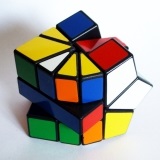 The Square-1 (originally called “Back to Square One” and “Cube 21”) is a completely different puzzle to any normal Rubik’s Cube themed puzzle. The original name “Cube 21” was coined as the Square-1 was deemed to be a “cube for the 21st century”, implying an unprecedented level of difficulty. The puzzle can technically “shape-shift”, although it always remains as a 3 layered puzzles (the only difference the “shape-shifting” makes is it mixes the corners and edges on the top and the bottom layers of the puzzle). In fact, the first stage of a conventional Square-1 solving method is “cube-shape”, in which the corners and edges of the top layer must be separated back into their original configuration – a cube. The Square-1 is also an official WCA event.
The Square-1 (originally called “Back to Square One” and “Cube 21”) is a completely different puzzle to any normal Rubik’s Cube themed puzzle. The original name “Cube 21” was coined as the Square-1 was deemed to be a “cube for the 21st century”, implying an unprecedented level of difficulty. The puzzle can technically “shape-shift”, although it always remains as a 3 layered puzzles (the only difference the “shape-shifting” makes is it mixes the corners and edges on the top and the bottom layers of the puzzle). In fact, the first stage of a conventional Square-1 solving method is “cube-shape”, in which the corners and edges of the top layer must be separated back into their original configuration – a cube. The Square-1 is also an official WCA event.
Find more twisty puzzles and their solution tutorial in the navigation or in the sidebar.
If you want to start collecting collect these toys you might find interesting the "Rubik's Cube Collection" page.

